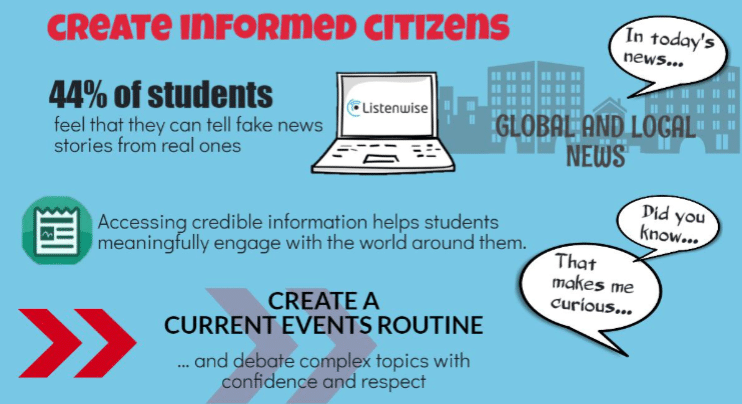Last Updated on December 13, 2021
 Using a story can engage students in current, local topics that relate to content you are teaching. These stories can be used throughout instruction to engage students, to practice listening, to extend learning, to reinforce content and concepts, to support research, or as a review of content. They can also clarify concepts, preview a unit, provide background information, teach academic vocabulary, support assignments, or spark class discussions. Try out a few of these ideas for integrating these audio stories into your instruction.
Using a story can engage students in current, local topics that relate to content you are teaching. These stories can be used throughout instruction to engage students, to practice listening, to extend learning, to reinforce content and concepts, to support research, or as a review of content. They can also clarify concepts, preview a unit, provide background information, teach academic vocabulary, support assignments, or spark class discussions. Try out a few of these ideas for integrating these audio stories into your instruction.
- Engage Students in Class Discussions
Use these public radio stories to provide students opportunities for rich discussion. Research shows students can listen 2 to 3 grade levels above what they can read, which allows a whole class to hear the same content and respond to ideas in a way that might not be possible using text. Encourage all students to participate in discussions using the Discussion Themes, and have students form their own opinions on the content. They can discuss or debate their ideas using evidence from the audio story. Stop the audio at good discussion points and create a social and interactive experience where students share their reactions and ideas with the class. - Increase Listening Comprehension
Developing good listening skills need to be taught and practiced. Just as you would model what a good reader does, model what a good listener does. Listen to these audio stories and talk through your thought process to show students your thinking. Did you make connections during the story? What did you have more questions about? What do you think about what you heard? When the content is more complex, students may need more time to absorb the concepts. Go slowly and stop the audio to review what was said or to clarify content as needed. - Expand Vocabulary Acquisition
Listening to a variety of topics provides students with exposure to a wide range of academic language. Students can learn the meaning of words through context and repeated exposure. Listening to audio stories allows them to stretch their vocabulary abilities and increase their acquisition of academic language, which is critical for educational success. - Connect Curriculum and Local Events
Listening to current public radio stories from real people in the news in their communities helps students relate to events that happened long ago. These high-quality, authentic stories are aligned to curriculum, creating a connection between students’ worlds inside and outside school. Listening to content in this format helps students gain skills and knowledge and can be used to build background on an unfamiliar topic, provide another point of view, or connect ideas across the curriculum. - Engage Families and the Community
These stories can be useful in expanding learning at home and within the community. Because the content comes from authentic public radio stories, students have the opportunity to become better citizens who are able to discuss local issues. Consider assigning a current event for students to listen to at home with their parents or guardian. Increase family involvement by having students create their own questions that will spark good discussions at home. Here are 5 ways to engage parents and families using Listenwise. - Develop Creativity and Visualizing Skills
Every time students hear something, the brain visually simulates what it hears. This makes listening an extremely visual medium with great potential for learning. When listening with students encourage them to create mental images, simulating what it’s like to “be there” in a scene. This helps students create a more meaningful, personal experience to what they are hearing, and students are able to recall the content for longer periods of time.
If you are looking for more ways you can use audio in your instruction, check out our infographic on ways to use Listenwise or visit our Teacher Support site.
